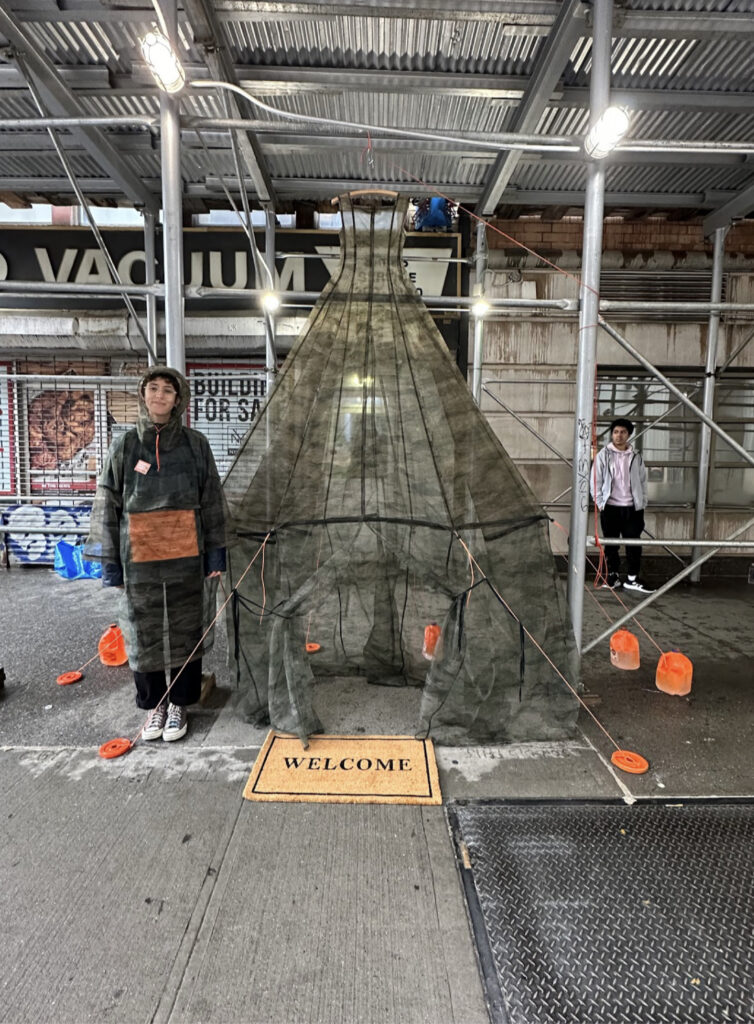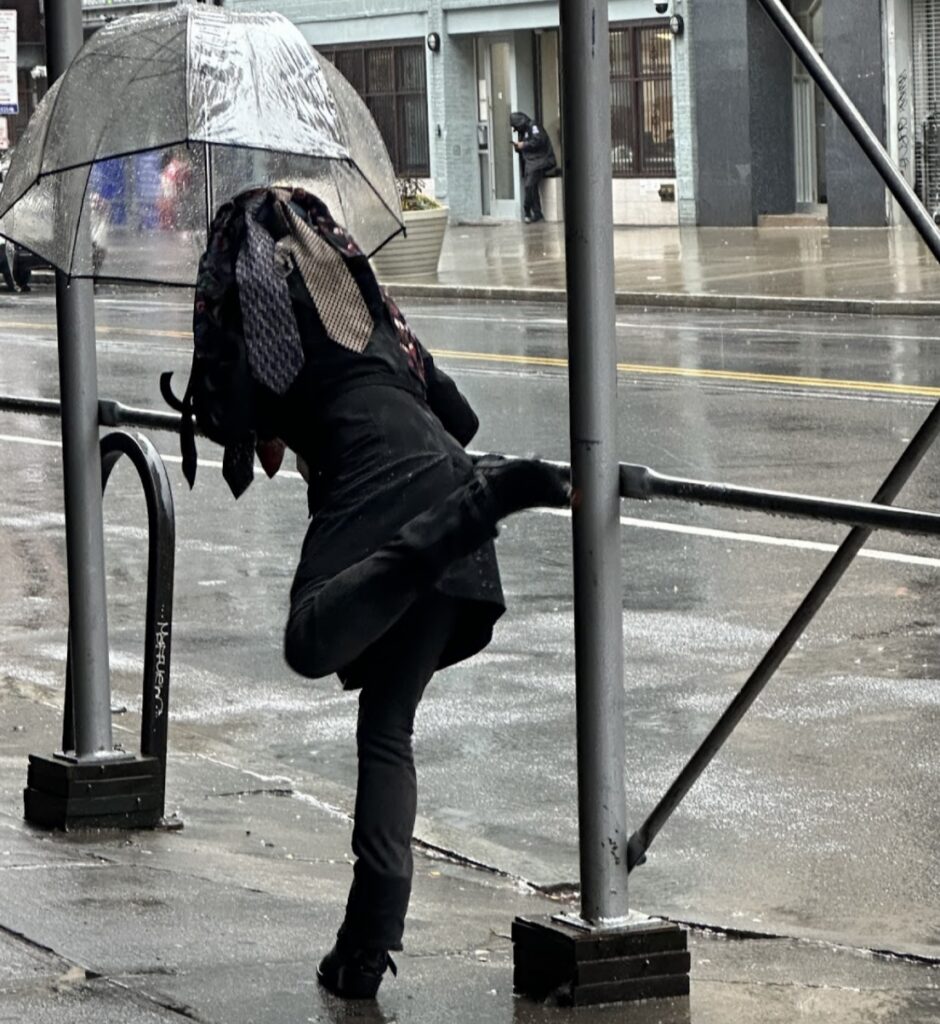All Dressed Up and Everywhere to Go
By Yasmeen Abdallah
The day began as a cold, rainy day in New York City, when the gloomy weather matched the tone of the heartbreaking tragedies unfolding in the Middle East. The cold that chilled to the bone and the grayness that blanketed the sky were befitting of the collective despair. It was a day that matched the mood of the world. Despite the feelings that loomed large, I arrived at the designated meeting place outside Parsons School of Design to take part in Miki Watanabe Spiller’s intervention, Banned Book Banditos. I was so very glad that I did. Micki’s project was created in response to the right-wing agenda of erasing history through the barring of literature it finds “woke” (with the agenda of suppressing the rights of BiPOC, trans, LGBTQ+ folx, womyn, drag performers, and basically anyone else critical of their oppressive actions). I firmly believe in Micki’s work, and recognize how important it is to stand up to this dangerous mode of historical redaction and total oppression. Adorned in embroidered felt and leather bandoliers and badges, we marched in boots and cowboy hats, carrying books such as Animal Farm, Brave New World, Slaughterhouse Five, The Color Purple, The Catcher in the Rye, Lord of the Flies, and The Grapes of Wrath. Marching in the Banned Book Banditos action helped to healthily expel the frustration that has been building up in response to these awful and divisive tactics. To share space and talk to people during this event felt supportive and inclusive. Micki gifted many people that weekend with banned book patches and zines, packed densely with information. She led the book bandits in the quest to protect free thought and the written word through connectivity, wisdom, respect and kindness.
Some of the AiOP: DRESS performers were unfortunately unable to take part in the rain due to the delicate qualities of their costumes, but those that did brave the weather did so with grit, determination, and commitment to their projects unlike anything I had seen. I took the afternoon to imagine AiOP: DRESS as a symposium, with each presenter sharing their skill sets, their knowledge bases, their interpretations of a theme. I contemplated the utopia that is an art festival along one of the busiest streets in one of the busiest cities in the world. I observed, year after year, first as an AiOP: BODY volunteer; then as part of AiOP: NORMAL’s curatorial team from 2020-2021; later as a participating artist in AiOP: STORY, up to presently as a Thinker-in-Residence for AiOP: DRESS. Within each role, I have been consumed by the infinite mirror concept of people watching that occurs annually. Operating without permits, without a budget, it’s a festival of freedom and experimentation. Passersby watch performers, at times unsure if it’s art or just New York. As a participant in various capacities through the years, I’ve been hypnotized by the act of observing observers who are observing. This meta-morphosis is a spectacle unto itself that invokes a giddiness in the sheer pleasure of being aware, alive, and present in the moment; the moment being monumentalized through the sheer creative output paving the streets with unexpected treasures, often in the oddest of places, indeed.
The seemingly endless construction along the 14th Street route of the AiOP festival was brilliantly punctuated by clever artists that took refuge beneath the frequent building scaffolding, turning various plywood structures into public dressing rooms, dance studios, runways, textile centers, and ad hoc pop-up galleries. The clever inventiveness and resilience lent enough emotional strength that I was able to lose myself for a bit in the quest to experience as many artists as possible. The performing interventions
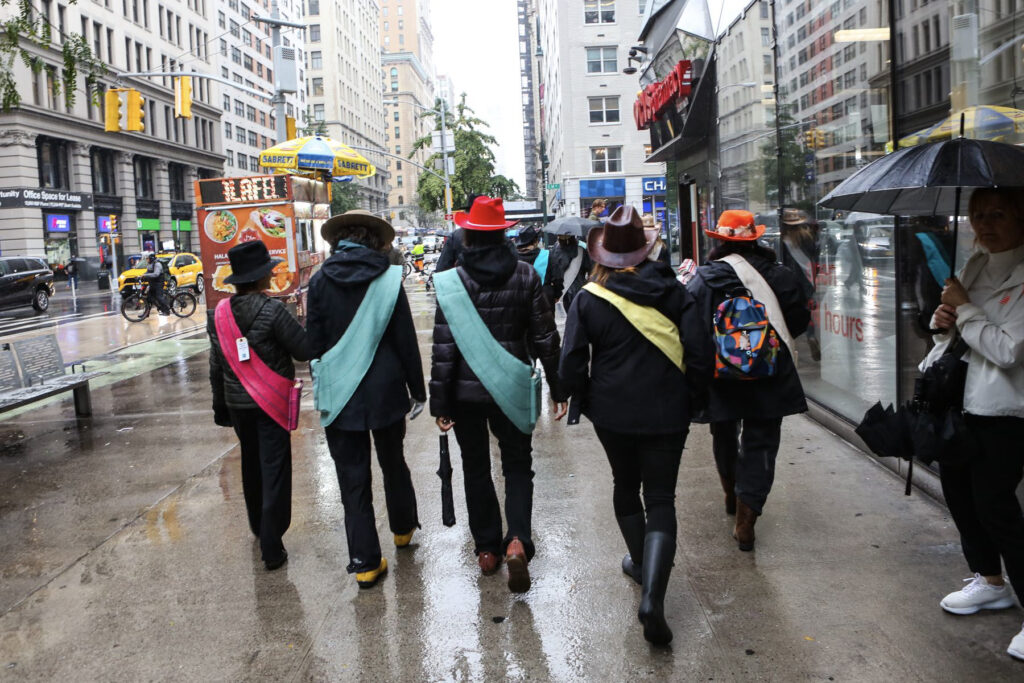
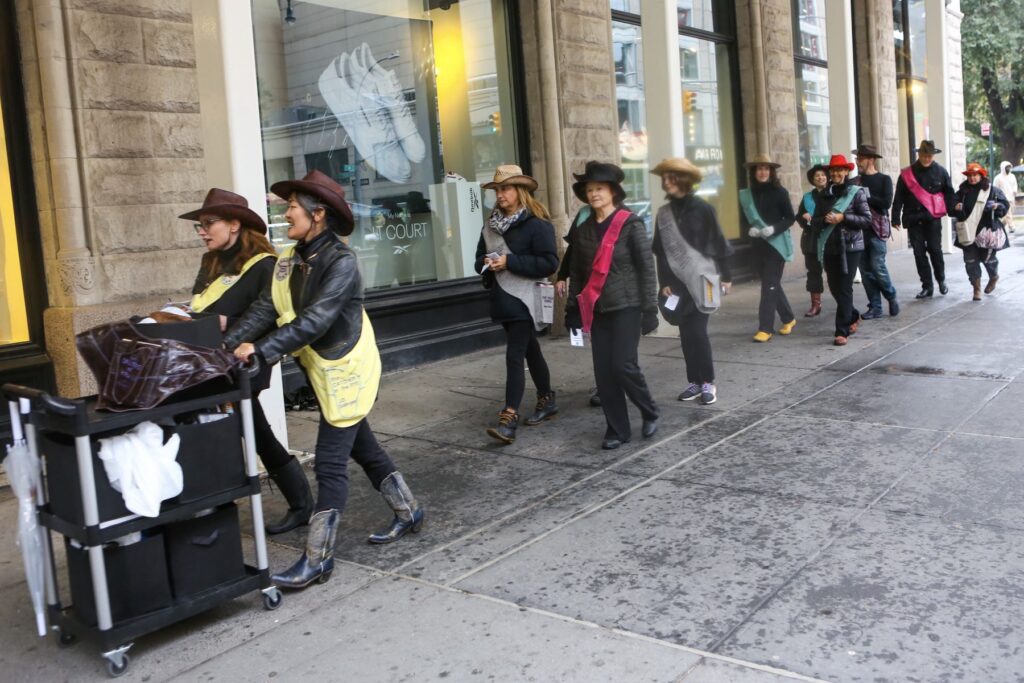
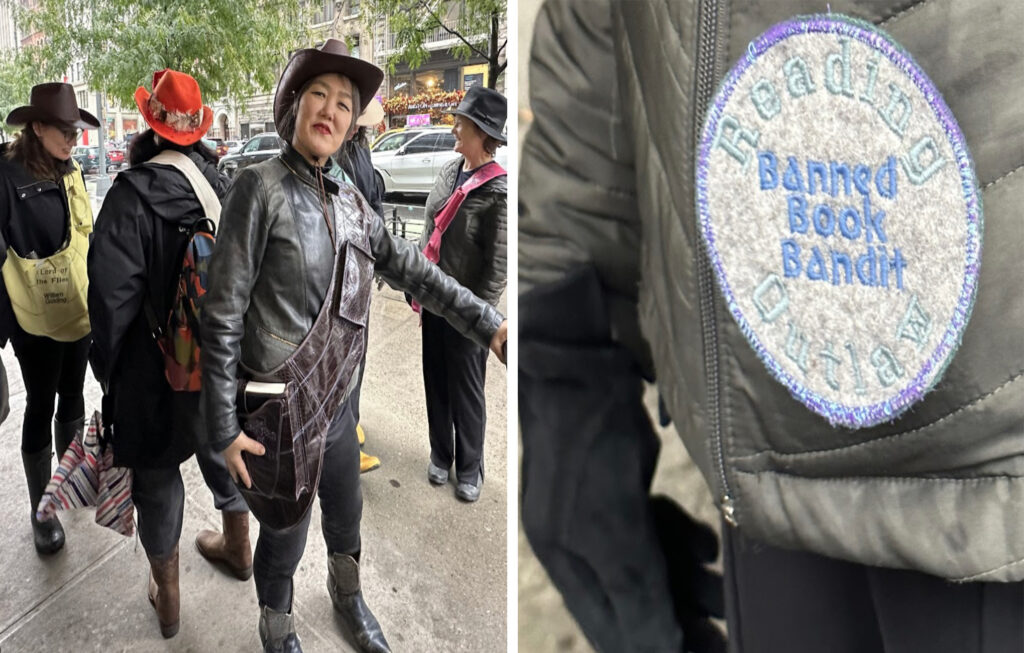
After Banned Books Banditos concluded, I began to make my way across 14th Street, searching for performers, interventions, and art that caught my eye. I encountered Margaret Chodos-Irvine’s SHELTER: No-See-Um installation, which was amazing. The concept of the No-See-Um caught me immediately. Large and yet unassuming, save for the orange weights to secure it, I was transfixed by the way it worked with the construction site in such a fitting way. It looked like it indeed belonged there, its specificity to the site aligned so concisely between form and content. The references to dress forms, boning, fashion, sculpture, and monuments under the guise of being unseen was profound. Only a story-teller could wear an experience as deftly as this. It turns out, in fact, that No-See-Um artist, Margaret Chodos-Irvine, was, in fact, a children’s illustrator before making garments and installations. Her daughter, Ella, is a graphic designer, and was on hand to generously speak with and share these insights with me. They have collaborated on work, and I was enamored with the closeness of their relationship. Additionally, Chodos-Irvine’s background is in both Art and Anthropology, like me, and it seems we both share an affinity for exploring the terrains between art and craft. It was a kindred spirit moment of consciousness that I was delighted to experience. It’s amazing what and who you will encounter on a walk down the street!

MiSWiP’s Amanda Wu and CY presented their project, Let’s Make an Outfit, and in another act of care, generously utilized some of their hand-embroidered garments from their project, to warm me up amidst the cold and drafty weather. Swaddled in the warmth of their kindness, I took in the performance with wonderment and enjoyment. They brilliantly incorporated the metal poles affixed to the plywood construction to create a mise en scene that depicted Wu dressing and undressing for the day, reading the text they lovingly embroidered by hand (which took an extensive amount of time to do, CY confirmed). With nothing but a thin layer of tarp between Wu’s socks and the sidewalk, I watched the commitment to the role. Undressing on the sidewalk on a cold rainy day down to a nude-colored bodysuit, and gradually adding layer after layer, learning the negative environmental impacts of each article of fast fashion was a moving performance to witness. The dedication to environmentalism, equity, and labor, MiSWiP’s Let’s Make an Outfit taught me a lot of important information that I had previously been unaware of, and as someone engaged in environmentalism, that says a lot. Their research was excellent, the presentation was engaging, and they presented solutions to our current climate crisis. It was a fantastic event that I’m so happy I was able to experience.

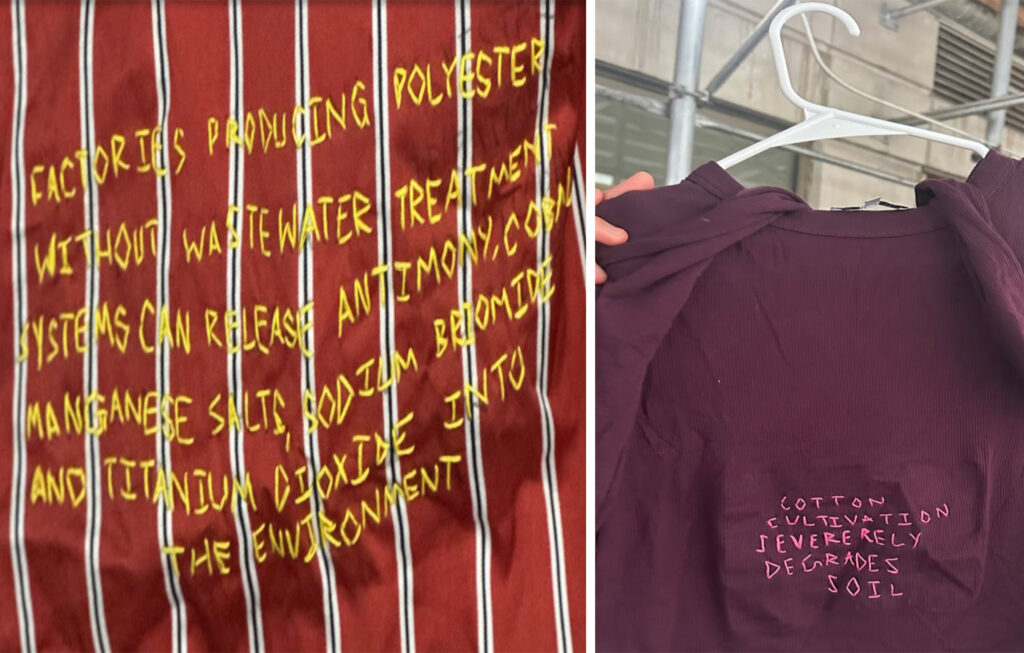
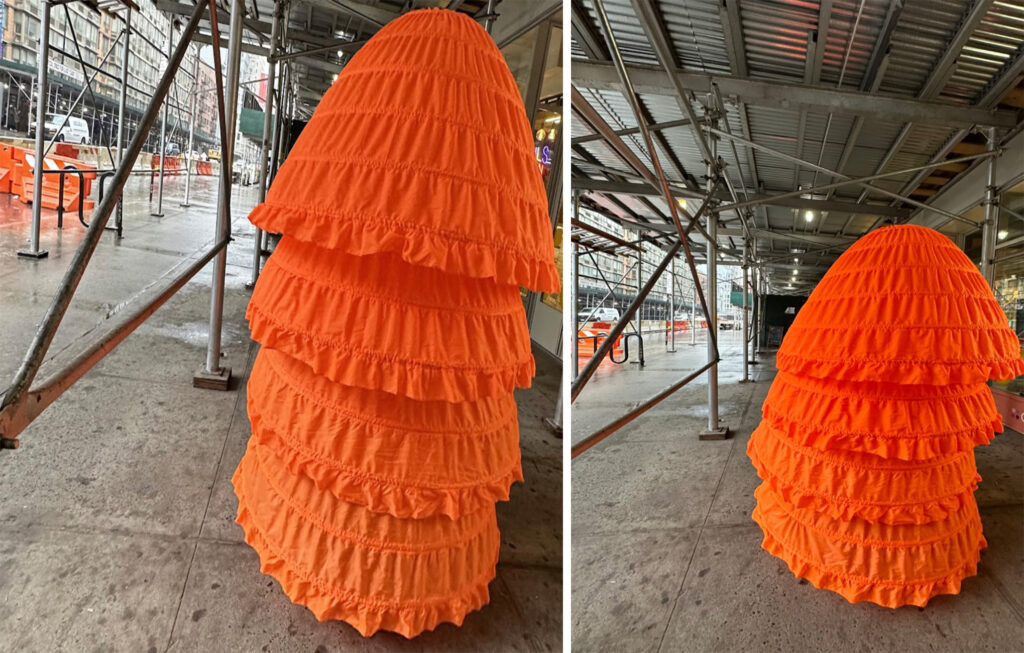
Stumbling upon Christopher Kaczmarek and Patricia Miranda’s collaboration, Layers of Exuberance was a treat. I admired the dialogue between their looming and surreal orange form that Kaczmarek was moving across the block in with the orange construction road blockades. This dynamic between what is supposed to be static, and what is bumbling around on public sidewalks was a quirky encounter to behold. The genteel elegance of the garment’s construction was a punctual play on the boxy, (dare I say macho) definition of the city barriers. This playful encounter offered some much needed brightness and welcoming irony and bliss on this rainy day. It further defied expectations when Vanessa Fairfax-Woods arrived, furthering the connections between form, function, and societal norms and defiances of said norms. Fairfax-Woods’ project reflected on the impossibility of living up to beauty expectations that project negative and harmful outcomes through body shaming. The artist created a couture body suit that addressed this issue, and the dynamic between the projects was a spiritual event I was grateful to witness. AiOP was in full force and representing the future that artists want to see.
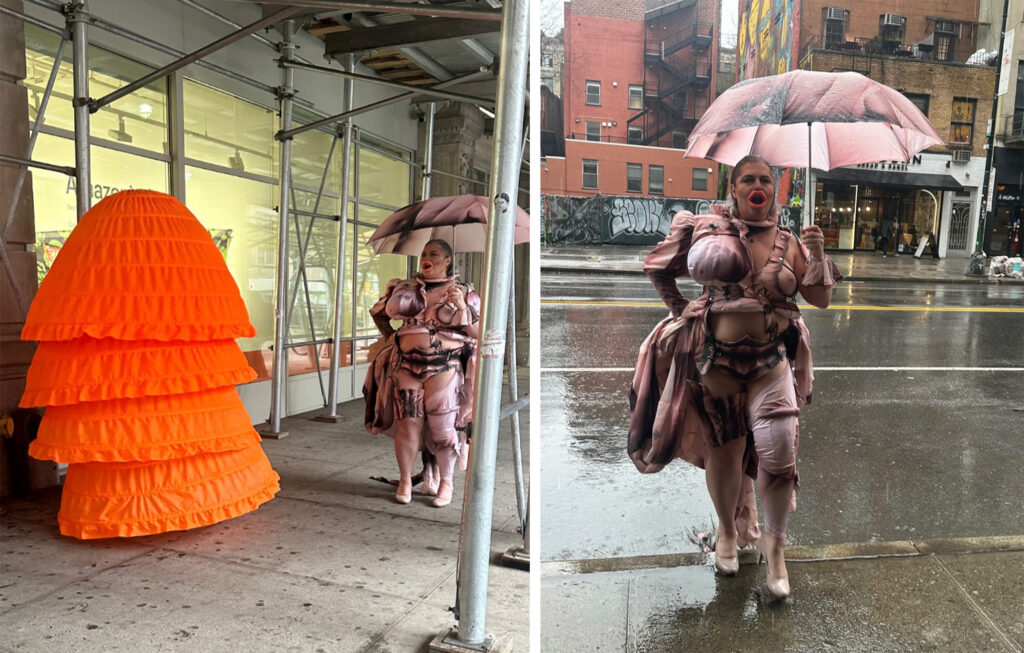
I walked further and approached the work of artist Kasia Ozga, whose textile installations, Wear Out: Manual Labor, are an ode to the working-class and gig workers around the globe. Ozga described the importance of acknowledging the labor that goes unnoticed, unappreciated, and undervalued. The initially beautiful swaths of blues reveal holes, tears, and imperfections caused by such labor, and to see these standard issue uniforms pastiched en masse in this way certainly made a profound impact. Ozga spoke of how the installation was composed of the garments of 300 workers in France as part of a public art project, and later was exhibited as part of a flag exchange in Portland, Oregon during Textile Month. What if these were the flags societies waved, acknowledging and paying homage to the very people that keep the world going? What if the majority of workers around the world did not have to fight for livable wages, access to quality healthcare, basic living standards, and to be treated with dignity? What if essential workers were honored everyday, and not just in times of crisis? What an uplifting world that would be…

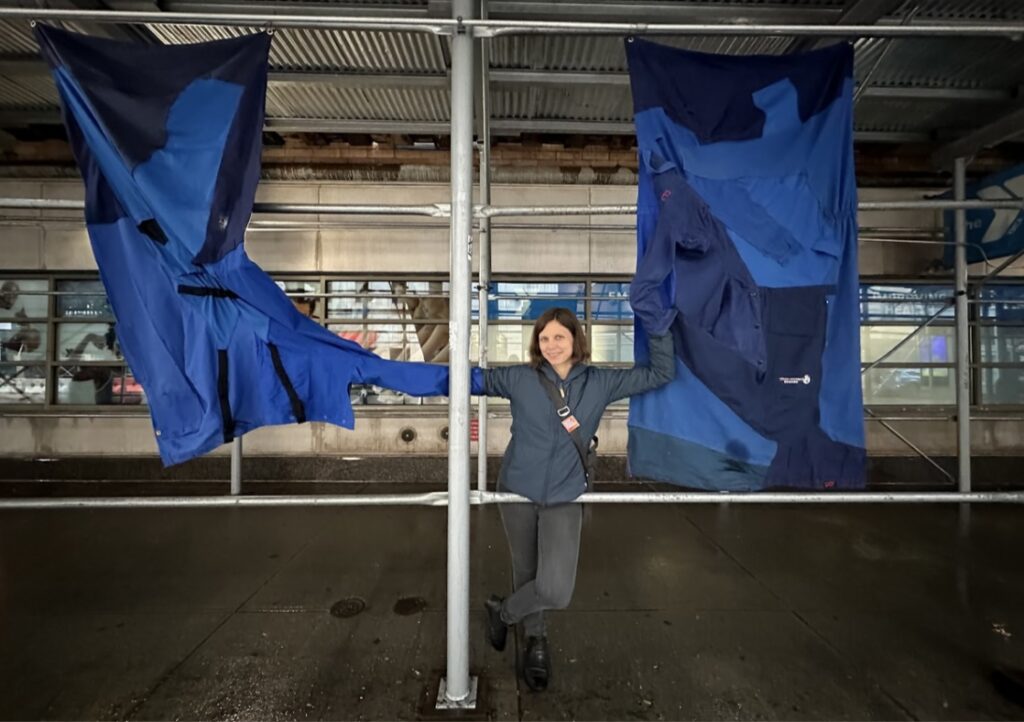
Next, I happened upon RETTOCAMME’s performance Statement Ties, with choreographer Emma Cotter moving along the sidewalk and construction scaffolding in an elegant and entrancing dance that bound the concrete and metal backdrop into a dreamy and theatrical set. Balancing a clear umbrella with a complex wearable artwork as a headpiece, I was spellbound by the grace and evocative ease in which Emma moved. Upon speaking with Emma, I learned that it’s actually difficult to see while wearing the necktie headdresses (which are created by collaborator Ryan Roth), and that the headdress actually would be different each day of the festival. Emma also shared that RETTOCAMME is a longtime member of the AiOP family, having performed twice with the festival earlier in Orlando.

Deirdre Macleod described her project, Ravel, as “Weaving into the fiber of the city”. This poetic act of sitting on the sidewalk and weaving was a moving experience to witness. MacLeod explained that she was unraveling the weaving she had created “as a way of reweaving herself into it”. Macleod’s project reflects upon the act of taking the same fabric from place to place, acknowledging how, as she moves through space, the various people change the work, as does the location. Acknowledging the city grit, the project and the weaving began in Edinburgh, Scotland and traveled across the Atlantic to New York, paying tribute to the Harris Tweed Weavers of Scotland who emigrated here a century ago, donning Harris Tweed to honor the occasion. Macleod was lovely to speak with, and revealed that she is also an educator in Scotland. Her dedication, care and commitment was clear and as beautifully woven into the fibers of her being as the project itself.
After some hot soup and tea to warm back up, we ventured back onto 14th Street to see what else we could find. What we caught was the wind down of Garbagia’s intervention, as the group paraded through the street, onto the sidewalk, and down the stairs of the inglorious L train, a beautiful note to close the day’s events. The feverish energy soared like a contagion through the chipped green paint of the subway. To bear witness to garbage sparkling like radiant jewels was indeed special and a rare occurrence. As a fellow repurposer of the unwanted, I was particularly impressed with their adaptations into high fashion extravaganza-wear. I was previously familiar with Garbagia through our shared connections to the Lower East Side, and particularly its art and activism work in beautifying public space through imbuing care into the discarded, with a loving ode to local hero Rolando Politi. This procession of fabulosity uplifted the heavy skies and was a reminder that we are neither alone in times of despair, nor isolated when we have creative outlets like art and dedication to shared values. AiOP is a reminder that we are a community of like-minded people, uniting in good times and bad, and making the ongoing fight for justice more bearable through solidarity and kind intention.
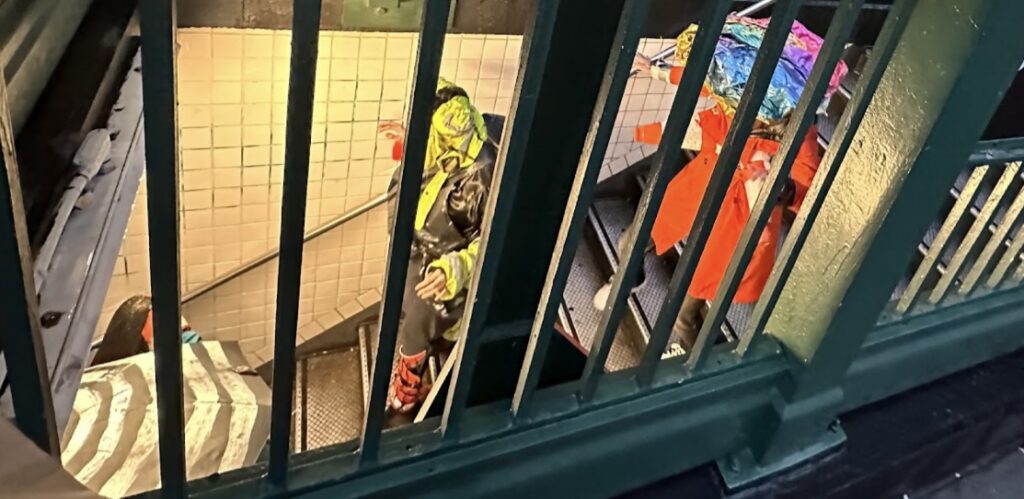
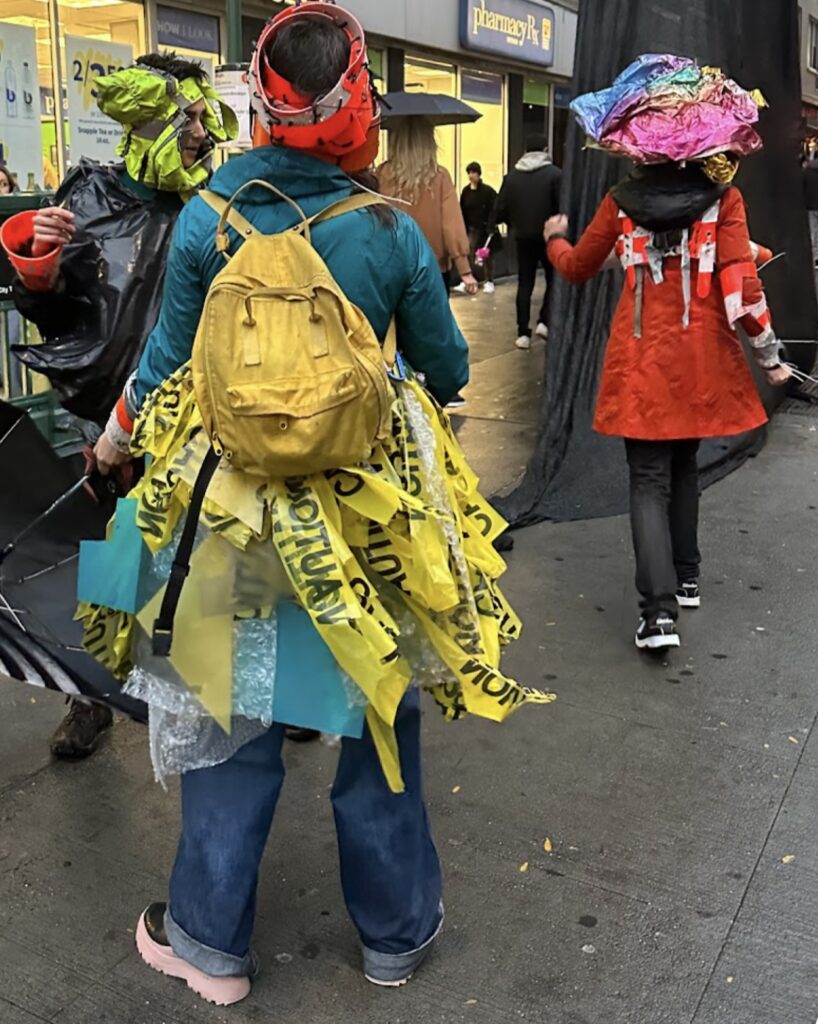
The following are two excerpts from interviews I conducted with Ed and Gretchen, who generously met with me just prior to this year’s festival, and had the following insights to share:
Yasmeen: Ed, as director and founder of the festival, you’ve kept the magic of AiOP alive and fresh for many years. How do you do it, and are you able to share some of your favorite and most memorable experiences over the years?
Ed: I do it because (like in the beginning), I thought it was important to create collective actions based on the ideology that public space is where we democratically communicate ideas for change. Taking art out of the institutions and commodified art market to a space offering art as an essential part of our everyday lives. AiOP is a model for making a substantial cultural impact without capital but instead with sincere generosity & curiosity.
The bundle of the continuing disappearance of civil liberties along with the unraveling of the fraud of the American Dream… and the more widespread knowledge that the United States is a policed state with organized police forces who act as mercenaries for corporate monopolies – I’d say Art in Odd Places is more important than ever.
Some favorite moments:
Observing the dynamics of each of the works in public space. Watching, deep listening, the profound study of the patterns, the unpredictability, and the continuing shift in specific individual communal outdoor public areas.
In the environment of a theater, a gallery, a museum – INSIDE – the relationship of the artist/performer and the audience is strictly controlled. But in civic space, the set of social regulations opens up more broadly to “the moment with so many variables that makes it wonderfully impossible to control
· Jenny Lando / Jenny and her two daughters sent me a letter (back in the day) describing the joy in their scavenger hunt for Art in Odd Places art projects along 14th Street. Her daughters went home to Astoria, Queens, and created their own Art in Odd Places in a nearby park.
· Sideshow / A fundraiser carnival sideshow circus with freaks, music, outrageous installations, and games on five floors at the now-defunct Theater Lab on 14th Street.
· House of AiOPY / a joyous raucous mashup spectacle of intergenerational, culturally extravagant performance and installation projects presented as a continuously running radical runway ballroom fashion show.
Having been profoundly impacted by Gretchen’s project for AiOP 2021: NORMAL, I spoke with Gretchen, regarding the evolving ideation between artistic practice and curatorial vision:
Yasmeen: Your practice explores notions of clothing and wearable modes of expression as extensions of the self; through concepts including visibility/invisibility; concealing/revealing; presence/absence; private/public; and uniformity/individuality. You’ve also been involved with AiOP in various capacities for many years. I fondly and vividly recall your work, Modern Plague Doctor in AiOP: NORMAL in 2021. Can you tell us more about that powerful creation? It, along with so many of your pieces, speaks deeply to so many issues inextricably connected within our society. How did you come to this place in your work?
Gretchen: AiOP 2021: NORMAL found us re emerging from the COVID pandemic lockdown after more than a year of physical separation and social protest where everyone had to reevaluate their definition of ‘normal’. We were all wearing masks and protective clothing. It had me thinking of previous pandemics, the plague doctor costume associated with the Black Death, the herbs that would have been used at that time, treatments based on the body “humors”. Also societal plagues, the plague of racism.
I’ve often worked with surface patterns on clothing, but the barrier of the mask led me to want to work with text as a way to counteract the physical distance, to express visually what a covered face could not.
The text was a love letter to New York, tributes to protest and victims of police violence, poems and stories, jokes, and beautiful herbal monographs placed near the organs associated with the herb/ or body humor —all of this also printed on Rx cards: prescriptions for humor, health and connection. My inspiration for the garment was modern PPE, mixed with the 17th Century plague doctor costume and a 1970s jumpsuit (inspired by Norma Kamali, The Wiz)
Portraying the modern plague doctor and handing out prescription cards was a very healing experience; taking a figure associated with darkness and death and turning it into something hopeful and light.
Thank you, AiOP, for keeping our spirits high during difficult times, and for reminding us that art can and does make a difference.
With love,
Yasmeen
. . .
Yasmeen Abdallah is an interdisciplinary artist, independent curator, educator and community organizer.
You can learn more about her work here: yasmeenabdallah.com Instagram: @86cherrycherry

